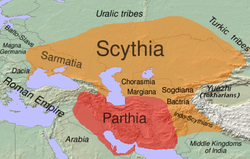Sarmatae
 Approximate extent of East Iranian languages in the 1st century BC is shown in orange. |
|
| Total population | |
|---|---|
| (Extinct) | |
| Regions with significant populations | |
| Eastern Europe Central Asia |
|
| Languages | |
| Scythian languages, East Iranian languages | |
| Related ethnic groups | |
|
Scythians, Sakas Descendants: Alans, Ossetians Clan Ostoja |
The Sarmatians (Latin: Sarmatae or Sauromatae, Greek: Σαρμάται, Σαυρομάται) were a large confederation of Iranian people during classical antiquity, flourishing from about the 5th century BC to the 4th century AD. They spoke Scythian, an Indo-European language from the Eastern Iranian family.
Originating in Eastern Europe, between the Don River and the Ural Mountains the Sarmatians started their westward migration around the 6th century BC, coming to dominate the closely related Scythians by the 2nd century BC. The Sarmatians differed from the Scythians in their veneration of the god of fire rather than god of nature, and women's prominent role in warfare, which possibly served as the inspiration for the Amazons. At their greatest reported extent, around 1st century AD, these tribes ranged from the Vistula River to the mouth of the Danube and eastward to the Volga, bordering the shores of the Black and Caspian seas as well as the Caucasus to the south. Their territory, which was known as Sarmatia to Greco-Roman ethnographers, corresponded to the western part of greater Scythia (mostly modern Ukraine and Southern Russia, also to a smaller extent north eastern Balkans around Moldova). According to authors Arrowsmith, Fellowes and Graves Hansard in their book A Grammar of Ancient Geography published in 1832, Sarmatia had two parts, Sarmatia Europea and Sarmatia Asiatica covering a combined area of 503,000 sq mi or 1,302,764 km2.
...
Wikipedia
